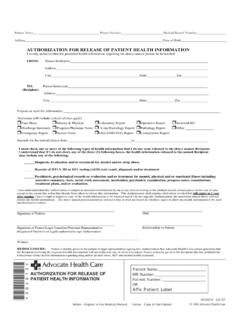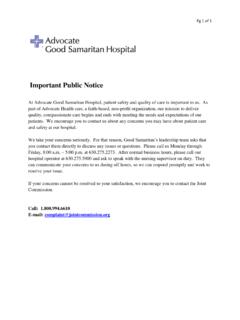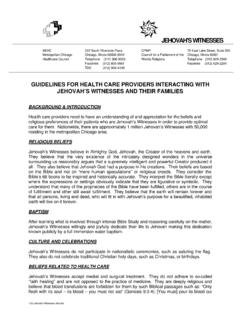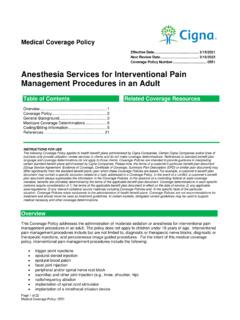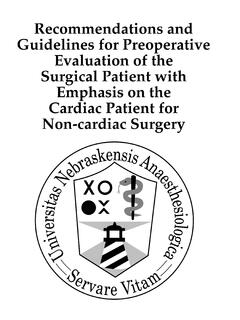Transcription of Medication Instructions Prior to Surgery
1 Medication Instructions Prior to Surgery Updated August 2016 The tables below offer guidance on whether to hold certain common classes of medications Prior to Surgery . It is not meant to replace sound clinical judgment. The decision of whether to give or hold medications should always take patient-specific considerations into account. The decision depends on the type of Surgery (organs involved, major vs minor), the duration, whether there will be epidural or spinal catheters placed, the urgency (elective vs emergent), and the current state of the patient s medical conditions (controlled or uncontrolled blood pressure or blood glucose, renal and hepatic function, thrombotic risk, etc.). Table 1. Cardiovascular Agents: ACE Inhibitors, ARBs, Diuretics, Statins, Others Medication Class Medication Names Instructions for Holding Reason Angiotensin Converting Enzyme (ACE) Inhibitors Benazepril + amlodipine (Lotrel) Benazepril (Lotensin) Benazepril + HCTZ (Lotensin HCT) Captopril (Capoten), Captopril + HCTZ (Capozide) Enalapril (Vasotec), Enalapril + HCTZ (Vaseretic) Fosinopril (Monopril) Fosinopril + HCTZ (Monopril HCT) Lisinopril (Prinivil, Zestril) Lisinopril + HCTZ (Prinzide or Zestoretic) Moexipril (Univasc), Moexipril + HCTZ (Uniretic) Perindopril (Aceon) Quinapril (Accupril), Quinapril + HCTZ (Accuretic) Ramipril (Altace) Trandolapril (Mavik) Trandolapril + verapamil (Tarka)
2 Hold day of Surgery Adverse hemodynamic changes during Surgery ( hypotension) Angiotensin Receptor Blockers (ARBs) Azilsartan (Edarbi) Candesartan (Atacand), Candesartan + HCTZ (Atacand HCT) Eprosartan (Teveten) Eprosartan + HCTZ (Teveten HCT) Irbesartan (Avapro), Irbesartan + HCTZ (Avalide) Losartan (Cozaar) Losartan + HCTZ (Hyzaar) Olmesartan (Benicar) Olmesartan + HCTZ (Benicar HCT) Telmisartan (Micardis) Telmisartan + HCTZ (Micardis HCT) Valsartan (Diovan) Valsartan / HCTZ (Diovan HCT) Hold day of Surgery Adverse hemodynamic changes during Surgery ( hypotension) Medication Class Medication Names Instructions for Holding Reason Beta Blockers Beta Blocker/Diuretic Combinations Acebutolol (Sectral) Atenolol (Tenormin) Betaxolol (Kerlone) Bisoprolol (Zebeta) Carvedilol (Coreg) Metoprolol (Lopressor, Toprol XL) Nadolol (Corgard) Nebivolol (Bystolic) Penbutolol (Levatol) Pindolol (Visken) Propranolol (Inderal) Sotalol (Betapace) Atenolol/chlorthalidone (Tenoretic) Nadolol/bendroflumethiazide (Corzide) Bisoprolol/hydrochlorothiazide (Ziac) Propranolol/ hydrochlorothiazide (Inderide) Metoprolol/HCTZ (Lopressor HCT) Do NOT hold Withdrawal/rebound effects if held Calcium Channel Blockers Amlodipine (Norvasc) Clevipidine (Cleviprex) Diltiazem (Cardizem) Felodipine (Plendil) Isradipine (Dynacirc) Nicardipine (Cardene) Nifedipine (Procardia, Adalat) Nimodipine (Nimotop) Verapamil (Calan, Covera-HS, Verelan)
3 OK to continue unless significant bradycardia, hypotension, or left ventricular dysfunction (LVEF < 40%) Clonidine Clonidine (Catapres) Do NOT hold Withdrawal/rebound effects if held Digoxin Digoxin (Lanoxin) OK to continue Diuretics Acetazolamide (Diamox) Amiloride Amiloride/Hydrochlorothiazide (Moduretic) Bumetanide (Bumex) Chlorothiazide (Diuril) Chlorthalidone (Thalitone) Eplerenone (Inspra) Ethacrynic acid (Edecrin) Hold day of Surgery Increases the risk of hypokalemia / hypovolemia Furosemide (Lasix) Hydrochlorothiazide (HCTZ, Microzide) Indapamide (Lozol) Metolazone (Zaroxolyn) Methazolamide Metolazone (Zaroxoxlyn) Spironolactone (Aldactone) Spironolactone/HCTZ (Aldactazide) Torsemide (Demadex) Triamterene (Dyrenium) Triamterene / HCTZ (Dyazide, Maxzide) Renin Inhibitors Aliskiren (Tekturna) Aliskiren/Amlodipine (Tekamlo) Aliskiren/Amlodipine/HCTZ (Amturnide) Hold day of Surgery Hypotension during Surgery Statins Atorvastatin (Lipitor) Fluvastatin (Lescol) Lovastatin (Mevacor) Pitavastatin (Livalo) Pravastatin (Pravachol) Rosuvastatin (Crestor) Simvastatin (Zocor) Do not hold Table 2.
4 Anticoagulants and Antiplatelets Anticoagulants and antiplatelet agents are commonly held Prior to procedures due to an increased risk of bleeding. The risk of bleeding is higher for certain procedures and if renal or hepatic disease exists. Longer hold times are usually necessary for patients undergoing major Surgery , spinal puncture, or placement of a spinal or epidural catheter or port. The risk of a cardiovascular and/or thromboembolic event must always be weighed against the risk of bleeding for the specific patient and procedure. The risk of stent thrombosis is highest in the first 4 to 6 weeks after stent implantation. It is important to find out the indication for use of anticoagulants and antiplatelets ( , coronary artery disease, valve replacement, coronary stents, cerebrovascular disease [stroke], etc.)
5 As the recommendations differ. The decision to hold or continue and the optimal way to do so may need to be determined by consensus of the surgeon, anesthesiologist, cardiologist or neurologist based on the risks of bleeding and potential for thrombosis. Check with the appropriate physician for specific Instructions regarding IF, WHEN, and HOW to stop and restart therapy. Standard Bleeding Risk: breast biopsy, cardiac catheterizations, cataract Surgery , colonoscopy, electrophysiology procedures, lithotripsy, polypectomy, no additional patient specific risk factors High Bleeding Risk: Surgery involving major organs such as heart, neurosurgery, ophthalmologic, genitourinary, spine Surgery , procedures requiring hemostasis ( spinal anesthesia ) or when additional patient specific risk factors are present.
6 Medication Class Medication Name When to Hold Before Surgery Standard Bleeding Risk When to Hold Before Surgery High Bleeding Risk Minimum time to hold Prior to epidural catheter placement or spinal inj Minimum time to RESTART after catheter removal (must wait longer if traumatic puncture) Anticoagulants - Direct Thrombin Inhibitors Argatroban Bivalirudin (Angiomax) Dabigatran (Pradaxa) 4 hours 2 hours 24 hours if CrCl > 50mL/min 48 hours if CrCl 31-49mL/min 4-5 days if CrCl < 30 4 hours 2 hours 2-3 days if CrCl > 50 mL/min 2-3 days if CrCl 31-49mL/min 6 days if CrCl < 30 4 hours (aPTT <30) aPTT <30 2-4 days if CrCl > 50 mL/min 4-5 days if CrCl 31-49mL/min 6 days if CrCl < 30 2 hours 2 hours 24 hours. If VTE risk very high, can give half usual dabigatran dose 12 hours after removal Medication Class Medication Name When to Hold Before Surgery Standard Bleeding Risk When to Hold Before Surgery High Bleeding Risk Minimum time to hold Prior to epidural catheter placement or spinal inj Minimum time to RESTART after catheter removal (must wait longer if traumatic puncture) Anticoagulants - Factor XA Inhibitors Apixaban (Eliquis) Edoxaban (Savaysa) Fondaparinux (Arixtra) Rivaroxaban (Xarelto)
7 24 hours 24 hours hours if CrCl 50mL/min 48 hours if CrCl 15-49mL/min 2 days 24 hours if CrCl 30mL/min 48 hours if CrCl 15-30mL/min 3-5 days 72 hours if CrCl 50mL/min 96 hours if CrCl 15-50mL/min 3-4 days 72 hours if CrCl 30mL/min 96 hours if CrCl 15-30mL/min 24 hours 72 hours if CrCl 50mL/min 96 hours if CrCl 15-50mL/min 48 hours (prophylactic dosing), 3-4 days (treatment dosing) 72 hours if CrCl 30mL/min 96 hours if CrCl <30mL/min 24 hours 24 hours 24 hours 24 hours. If VTE risk very high, can give half usual rivaroxaban dose 12 hours after removal Anticoagulants - Heparin Heparin IV Heparin subQ 4 hours 8-10 hours 4-6 hours 8-10 hours 4 hours (PTT <33) 8-10 hours 2 hours. Time to resume may be up to 24 hr if traumatic puncture Anticoagulants - Low molecular weight heparin Enoxaparin (Lovenox) or Dalteparin (Fragmin) Prophylactic dosing 12 hours 12 hours 12 hours 4-24 hours depending on bleeding risk of procedure Anticoagulants - Low molecular weight heparin Enoxaparin (Lovenox) or Dalteparin (Fragmin) Treatment dosing 24 hours 24 hours 24 hours 4 hours low risk; 12-24 hrs after medium and high bleeding risk procedure Anticoagulants - Warfarin Warfarin (Coumadin) be sure to consider thrombotic risk and need for bridging with low molecular weight heparin or heparin Shared assessment risk and decision between treating physicians recommended.
8 5 days and INR < 5 days and INR < 24 hours Medication Class Medication Name When to Hold Before Surgery Standard Bleeding Risk When to Hold Before Surgery High Bleeding Risk Minimum time to hold Prior to epidural catheter placement or spinal inj Minimum time to RESTART after catheter removal (must wait longer if traumatic puncture) Antiplatelets Aspirin & aspirin-containing products Aspirin Shared assessment risk and decision between treating physicians recommended. Aspirin and aspirin-containing products used for analgesia (Excedrin, Fiorinal, Soma Compound, Norgesic, Percodan) Patients with CAD, recent stent placement, stroke, should be continued on aspirin whenever possible. Peripheral Vascular or Cardiac Surgery .
9 Patients may be asked by the surgeon to continue aspirin until time of Surgery 7 days 4-6 days (especially ophthalmologic [not cataract], neurosurgical, ortho spine procedures) 7 days 6 days 24 hours Antiplatelets Cilostazol (Pletal) Dipyridamole (Persantine) Aspirin/ dipyridamole (Aggrenox) 48 hours 48 hours 7 days 48 hours 48 hours 7 days 48 hours 48 hours 6 days 24 hours 24 hours 24 hours Antiplatelets P2Y12 Inhibitors Refer to disclaimer above regarding indication and stents Clopidogrel (Plavix) Prasugrel (Effient) Ticagrelor (Brilinta) Ticlopidine (Ticlid) 7 days 7 days 5 days 14 days 7 days 7 days 5 days 14 days 7 days 7 days 5 days 14 days 12 hours; 24 hours if loading dose 24 hours 24 hours 24 hours Medication Class Medication Name When to Hold Before Surgery Standard Bleeding Risk When to Hold Before Surgery High Bleeding Risk Minimum time to hold Prior to epidural catheter placement or spinal inj Minimum time to RESTART after catheter removal (must wait longer if traumatic puncture) Antiplatelets GPIIb/IIIa Inhibitors Abciximab (Reopro) Eptifibatide (Integrilin) Tirofiban (Aggrastat) 48 hours 8 hours 8 hours 5 days 24 hours 24 hours 5 days 24 hours 24 hours 8-12 hours 8-12 hours 8-12 hours Antiplatelets - Analgesics Short-acting NSAIDs Diclofenac (Cataflam, Voltaren) Ibuprofen (Advil, Motrin) Ibuprofen/Hydrocodone (Vicoprofen)
10 Ibuprofen/Oxycodone (Combunox) Fenoprofen (Nalfon) Ketoprofen ketorolac (Toradol) Meclofenamate Mefenamic Acid Tolmetin Diflunisal Etodolac (Lodine) Indomethacin (Indocin) Flurbiprofen Day Prior to Surgery 2 days Day Prior to Surgery 24 hours 24 hours Antiplatelets - Analgesics Long-acting NSAIDs Meloxicam (Mobic) Naproxen (Aleve, Anaprox, Naprosyn) Sulindac Nabumetone (Relafen) Oxaprozin (Daypro) Piroxicam (Feldene) 4 days 6 days 10 days 4 days 4 days 24 hours Antiplatelets - Analgesics Cox-2 Inhibitors Celecoxib (Celebrex) OK to continue OK to continue No restrictions No restr
